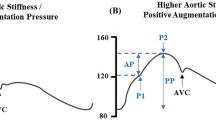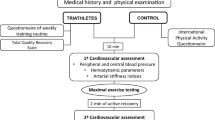Abstract
Purpose
Endurance exercise improves cardiovascular health and reduces mortality risk. Augmentation index (AIx) reflects adverse loading exerted on the heart and large arteries and predicts future cardiovascular disease. The purpose of this study was to establish whether endurance athletes possess lower AIx and aortic blood pressure compared to healthy controls, and to determine the association between AIx and cardiorespiratory fitness.
Methods
Forty-six endurance athletes and 43 healthy controls underwent central BP and AIx measurements by non-invasive applanation tonometry before a maximal exercise test. Peak oxygen uptake (\(\dot{V}{\text{O}}_{{ 2 {\text{peak}}}}\)) was assessed by pulmonary analysis.
Results
Relative to controls, athletes had significantly lower brachial diastolic blood pressure (BP, −4.8 mmHg, p < 0.01), central systolic BP (−3.5 mmHg, p = 0.07), and AIx at a heart rate of 75 beats min−1 (AIx@75, −11.9 %, p < 0.001). No AIx@75 differences were observed between athletes and controls when adjusted for age and \(\dot{V}{\text{O}}_{{ 2 {\text{peak}}}}\) [athletes vs controls mean (%) ± SE: −6.9 ± 2.2 vs −5.7 ± 2.3, p = 0.76]. Relative to men with low \(\dot{V}{\text{O}}_{{ 2 {\text{peak}}}}\), those with moderate and high \(\dot{V}{\text{O}}_{{ 2 {\text{peak}}}}\) had lower age-adjusted AIx@75 (p < 0.001). In women, those with high \(\dot{V}{\text{O}}_{{ 2 {\text{peak}}}}\) had lower AIx@75 than those with low and moderate \(\dot{V}{\text{O}}_{{ 2 {\text{peak}}}}\) (p < 0.01).
Conclusions
The lower AIx@75 in endurance athletes is partly mediated by \(\dot{V}{\text{O}}_{{ 2 {\text{peak}}}}\). While an inverse relationship between AIx@75 and \(\dot{V}{\text{O}}_{{ 2 {\text{peak}}}}\) was found in men, women with the highest \(\dot{V}{\text{O}}_{{ 2 {\text{peak}}}}\) possessed lowest AIx@75 compared to females with moderate or poor cardiorespiratory fitness. We recommend aerobic training aimed at achieving a minimum \(\dot{V}{\text{O}}_{{ 2 {\text{peak}}}}\) of 45 ml kg−1 min−1 to decrease the risk of future cardiovascular events and all-cause mortality.

Similar content being viewed by others
Abbreviations
- AIx:
-
Augmentation index
- AIx@75:
-
Augmentation index at heart rate of 75 beats per minute
- ANCOVA:
-
Analysis of co-variance
- AP:
-
Augmented pressure
- BMI:
-
Body mass index
- BP:
-
Blood pressure
- eNO:
-
Endothelial nitric oxide
- EPC:
-
Endothelial progenitor cell
- NOS:
-
Nitric oxide synthase
- \(\dot{V}{\text{O}}_{{ 2 {\text{peak}}}}\) :
-
Peak oxygen uptake
References
Agabiti-Rosei E, Mancia G, O’Rourke MF et al (2007) Central blood pressure measurements and antihypertensive therapy: a consensus document. Hypertension 50(1):154–160
Ashor AW, Lara J, Siervo M, Celis-Morales C, Mathers JC (2014) Effects of exercise modalities on arterial stiffness and wave reflection: a systematic review and meta-analysis of randomized controlled trials. PLoS One 9(10):e110034
Berry JD, Willis B, Gupta S et al (2011) Lifetime risks for cardiovascular disease mortality by cardiorespiratory fitness levels measured at ages 45, 55, and 65 years in men. The Cooper Center Longitudinal Study. J Am Coll Cardiol 57(15):1604–1610
Blair SN, Kampert JB, Kohl HW 3rd et al (1996) Influences of cardiorespiratory fitness and other precursors on cardiovascular disease and all-cause mortality in men and women. JAMA 276(3):205–210
Chirinos JA, Kips JG, Jacobs DR Jr et al (2012) Arterial wave reflections and incident cardiovascular events and heart failure: MESA (Multiethnic Study of Atherosclerosis). J Am Coll Cardiol 60(21):2170–2177
Denham J, Nelson CP, O’Brien BJ et al (2013) Longer leukocyte telomeres are associated with ultra-endurance exercise independent of cardiovascular risk factors. PLoS One 8(7):e69377
Denham J, O’Brien BJ, Prestes PR, Brown NJ, Charchar FJ (2015) Increased expression of telomere-regulating genes in endurance athletes with long leukocyte telomeres. J Appl Physiol (1985) 120(2):148–158
Duprez DA, Kaiser DR, Whitwam W et al (2004) Determinants of radial artery pulse wave analysis in asymptomatic individuals. Am J Hypertens 17(8):647–653
Edwards DG, Lang JT (2005) Augmentation index and systolic load are lower in competitive endurance athletes. Am J Hypertens 18(5 Pt 1):679–683
El Assar M, Angulo J, Rodriguez-Manas L (2013) Oxidative stress and vascular inflammation in aging. Free Radic Biol Med 65:380–401
Hayashi K, Sugawara J, Aizawa K et al (2008) Arterial elastic property in young endurance and resistance-trained women. Eur J Appl Physiol 104(5):763–768
Knez WL, Sharman JE, Jenkins DG, Coombes JS (2008) Central hemodynamics in ultra-endurance athletes. J Sci Med Sport 11(4):390–395
Kodama S, Saito K, Tanaka S et al (2009) Cardiorespiratory fitness as a quantitative predictor of all-cause mortality and cardiovascular events in healthy men and women: a meta-analysis. JAMA 301(19):2024–2035
Kroger K, Lehmann N, Rappaport L et al (2011) Carotid and peripheral atherosclerosis in male marathon runners. Med Sci Sports Exerc 43(7):1142–1147
Laufs U, Werner N, Link A et al (2004) Physical training increases endothelial progenitor cells, inhibits neointima formation, and enhances angiogenesis. Circulation 109(2):220–226
Laufs U, Urhausen A, Werner N et al (2005) Running exercise of different duration and intensity: effect on endothelial progenitor cells in healthy subjects. Eur J Cardiovasc Prev Rehabil 12(4):407–414
Laurent S, Cockcroft J, Van Bortel L et al (2006) Expert consensus document on arterial stiffness: methodological issues and clinical applications. Eur Heart J 27(21):2588–2605
Laurent P, Marenco P, Castagna O et al (2011) Differences in central systolic blood pressure and aortic stiffness between aerobically trained and sedentary individuals. J Am Soc Hypertens 5(2):85–93
Lee HY, Oh BH (2010) Aging and arterial stiffness. Circ J 74(11):2257–2262
Lee DC, Artero EG, Sui X, Blair SN (2010) Mortality trends in the general population: the importance of cardiorespiratory fitness. J Psychopharmacol 24(4 Suppl):27–35
Lee DC, Sui X, Artero EG et al (2011) Long-term effects of changes in cardiorespiratory fitness and body mass index on all-cause and cardiovascular disease mortality in men: the aerobics center longitudinal study. Circulation 124(23):2483–2490
McEniery CM, Yasmin Hall IR et al (2005) Normal vascular aging: differential effects on wave reflection and aortic pulse wave velocity: the anglo-cardiff collaborative trial (ACCT). J Am Coll Cardiol 46(9):1753–1760
McEniery CM, Cockcroft JR, Roman MJ, Franklin SS, Wilkinson IB (2014) Central blood pressure: current evidence and clinical importance. Eur Heart J 35(26):1719–1725
Millet GP, Vleck VE, Bentley DJ (2009) Physiological differences between cycling and running: lessons from triathletes. Sports Med 39(3):179–206
Mitchell GF, Parise H, Benjamin EJ et al (2004) Changes in arterial stiffness and wave reflection with advancing age in healthy men and women: the Framingham Heart Study. Hypertension 43(6):1239–1245
Mobius-Winkler S, Hilberg T, Menzel K et al (2009) Time-dependent mobilization of circulating progenitor cells during strenuous exercise in healthy individuals. J Appl Physiol (1985) 107(6):1943–1950
Mohlenkamp S, Lehmann N, Breuckmann F et al (2008) Running: the risk of coronary events: prevalence and prognostic relevance of coronary atherosclerosis in marathon runners. Eur Heart J 29(15):1903–1910
Nordestgaard BG, Varbo A (2014) Triglycerides and cardiovascular disease. Lancet 384(9943):626–635
Nualnim N, Barnes JN, Tarumi T, Renzi CP, Tanaka H (2011) Comparison of central artery elasticity in swimmers, runners, and the sedentary. Am J Cardiol 107(5):783–787
Pihl E, Zilmer K, Kullisaar T et al (2003) High-sensitive C-reactive protein level and oxidative stress-related status in former athletes in relation to traditional cardiovascular risk factors. Atherosclerosis 171(2):321–326
Rehman J, Li J, Parvathaneni L et al (2004) Exercise acutely increases circulating endothelial progenitor cells and monocyte-/macrophage-derived angiogenic cells. J Am Coll Cardiol 43(12):2314–2318
Roman MJ, Devereux RB, Kizer JR et al (2007) Central pressure more strongly relates to vascular disease and outcome than does brachial pressure: the Strong Heart Study. Hypertension 50(1):197–203
Sandri M, Adams V, Gielen S et al (2005) Effects of exercise and ischemia on mobilization and functional activation of blood-derived progenitor cells in patients with ischemic syndromes: results of 3 randomized studies. Circulation 111(25):3391–3399
Schuler G, Adams V, Goto Y (2013) Role of exercise in the prevention of cardiovascular disease: results, mechanisms, and new perspectives. Eur Heart J 34(24):1790–1799
Swift DL, Lavie CJ, Johannsen NM et al (2013) Physical activity, cardiorespiratory fitness, and exercise training in primary and secondary coronary prevention. Circ J 77(2):281–292
Taylor BA, Zaleski AL, Capizzi JA et al (2014) Influence of chronic exercise on carotid atherosclerosis in marathon runners. BMJ Open 4(2):e004498
Thompson PD, Buchner D, Pina IL et al (2003) Exercise and physical activity in the prevention and treatment of atherosclerotic cardiovascular disease: a statement from the Council on Clinical Cardiology (Subcommittee on Exercise, Rehabilitation, and Prevention) and the Council on Nutrition, Physical Activity, and Metabolism (Subcommittee on Physical Activity). Circulation 107(24):3109–3116
Tomaszewski M, Charchar FJ, Przybycin M et al (2003) Strikingly low circulating CRP concentrations in ultramarathon runners independent of markers of adiposity: how low can you go? Arterioscler Thromb Vasc Biol 23(9):1640–1644
Tomaszewski M, Charchar FJ, Crawford L et al (2004) Serum C-reactive protein and lipids in ultra-Marathon runners. Am J Cardiol 94(1):125–126
Vaitkevicius PV, Fleg JL, Engel JH et al (1993) Effects of age and aerobic capacity on arterial stiffness in healthy adults. Circulation 88(4 Pt 1):1456–1462
Vlachopoulos C, Aznaouridis K, O’Rourke MF et al (2010a) Prediction of cardiovascular events and all-cause mortality with central haemodynamics: a systematic review and meta-analysis. Eur Heart J 31(15):1865–1871
Vlachopoulos C, Kardara D, Anastasakis A et al (2010b) Arterial stiffness and wave reflections in marathon runners. Am J Hypertens 23(9):974–979
Weber T, Auer J, O’Rourke MF et al (2004) Arterial stiffness, wave reflections, and the risk of coronary artery disease. Circulation 109(2):184–189
Wen CP, Wai JP, Tsai MK et al (2011) Minimum amount of physical activity for reduced mortality and extended life expectancy: a prospective cohort study. Lancet 378(9798):1244–1253
Williams PT (2001) Physical fitness and activity as separate heart disease risk factors: a meta-analysis. Med Sci Sports Exerc 33(5):754–761
Acknowledgments
We would like to thank the Victorian Government’s Infrastructure Support Program and the Federation University Australia ‘Self-sustaining Regions Research and Innovation Initiative’, an Australian Government Collaborative Research Network (CRN), for their support. Professor Charchar is supported by the National Health and Medical Research Council (project Grant: GNT1009490).
Author information
Authors and Affiliations
Corresponding author
Ethics declarations
Conflict of interest
None declared.
Additional information
Communicated by Keith Phillip George.
Rights and permissions
About this article
Cite this article
Denham, J., Brown, N.J., Tomaszewski, M. et al. Aortic augmentation index in endurance athletes: a role for cardiorespiratory fitness. Eur J Appl Physiol 116, 1537–1544 (2016). https://doi.org/10.1007/s00421-016-3407-x
Received:
Accepted:
Published:
Issue Date:
DOI: https://doi.org/10.1007/s00421-016-3407-x




